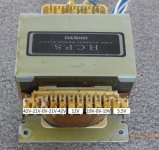Hi Guys,
I have a few large EI core power transformers salvaged from faulty home theatre receivers. They all seem to be a centre tapped transformer rather than dual secondaries as is my preference.
So the question is:
Can I 'cut' the 2 sides of a CT to create dual secondaries?

Its not quite clear on the photo, however the 0v clearly has 2 wires going to the 'spike'. Could I separate these 2 wires and create 2: 0v-21v-42v secondaries or would I be doing something silly that I am not forseeing?
I have a few large EI core power transformers salvaged from faulty home theatre receivers. They all seem to be a centre tapped transformer rather than dual secondaries as is my preference.
So the question is:
Can I 'cut' the 2 sides of a CT to create dual secondaries?

Its not quite clear on the photo, however the 0v clearly has 2 wires going to the 'spike'. Could I separate these 2 wires and create 2: 0v-21v-42v secondaries or would I be doing something silly that I am not forseeing?
it would become 21 0 21 and 21 0 21 or 2 42v windings.
easy to verify, and rather then cut the wire risking being left with to short a piece to make a good connection i would desolder and unwrap...
easy to verify, and rather then cut the wire risking being left with to short a piece to make a good connection i would desolder and unwrap...
Thanks,
I will desolder the wires off of the spike thingy and separate the two rather than cutting.
Am I likely to run into issues with the phase or is phase not really an issue when using 2 independent rectifiers?
I will desolder the wires off of the spike thingy and separate the two rather than cutting.
Am I likely to run into issues with the phase or is phase not really an issue when using 2 independent rectifiers?
Thanks,
I will desolder the wires off of the spike thingy and separate the two rather than cutting.
Am I likely to run into issues with the phase or is phase not really an issue when using 2 independent rectifiers?
Not an issue with full wave bridge rectifiers.
differences in phase....? so long as you respect what your sending to the rectifier all should be good (21+, 0 , 21- and 21+, 0 ,21- ( in that order) 'cause the windings are not likely to change direction with respect to the primary) and given two independent rectifiers, no.
Am I correct that the phase would only be important if I was connecting 2 secondaries in series?
If the phase was incorrect the pulses would cancel each other out leaving 0v and a very warm transformer?
If the phase was incorrect the pulses would cancel each other out leaving 0v and a very warm transformer?
Get the phase backwards with windings in series and you get zero volts with a very cold transformer. Get the phase backwards with windings in parallel and you get zero volts and a very hot transformer. In the former case there is zero current, in the latter there is “a lot” of current (effectively Shorted secondary).
If two completely separate windings are independently rectified the only thing that matters is the polarity of the DC at the outputs. Swapping the AC inputs to either rectifier dont matter at all because the diodes will steer the currents in the proper direction.
If two completely separate windings are independently rectified the only thing that matters is the polarity of the DC at the outputs. Swapping the AC inputs to either rectifier dont matter at all because the diodes will steer the currents in the proper direction.
- Home
- Amplifiers
- Power Supplies
- Turning a centre tap transformer into dual secondaries